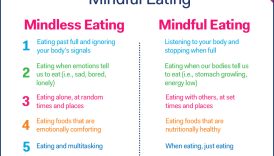The Journey to Wellness: Nurturing a Healthful Lifestyle

Importance of Wellness
Wellness is more than just the absence of illness; it encompasses a holistic approach to health, integrating physical, mental, and emotional well-being. It’s like tending to a garden where each aspect—nutrition, fitness, mental clarity—plays a vital role in cultivating a thriving life. When individuals prioritize their well-being, they unlock the potential for a more vibrant, fulfilling existence.
- The Journey to Wellness: Nurturing a Healthful Lifestyle
- Importance of Wellness
- Benefits of a Healthful Lifestyle
- Understanding Wellness
- Physical Well-being
- Mental Well-being
- Nutrition and Diet
- Balanced Diet
- Superfoods for Wellness
- Physical Fitness
- Exercise Routines
- Importance of Regular Physical Activity
- Mental Health
- Stress Management
- Mindfulness and Meditation
- Quality Sleep
- Importance of Sleep
- Tips for Better Sleep
- Emotional Well-being
- Building Emotional Resilience
- Practicing Gratitude
- Social Connections
- Impact of Social Relationships
- Nurturing Supportive Networks
- Holistic Wellness Practices
- Yoga and Meditation
- Alternative Therapies
- Setting Wellness Goals
- SMART Goals for Health
- Tracking Progress
- Healthy Habits
- Daily Routines
- Self-care Practices
- XII. Overcoming Obstacles
- Addressing Barriers to Wellness
- Seeking Professional Help
- XIII. Wellness in Everyday Life
- Incorporating Wellness into Daily Routine
- Finding Balance
- XIV. Celebrating Successes
- Acknowledging Achievements
- Rewarding Progress
- XVI. Conclusion
- Sustaining a Healthful Lifestyle
- Continuing the Journey to Wellness
Benefits of a Healthful Lifestyle
Embracing a healthful lifestyle brings with it a multitude of benefits, such as:
- Increased energy levels
- Improved concentration and productivity
- Enhanced mood and emotional resilience
- Strengthened immune system
For instance, after switching to a more balanced diet rich in fruits and vegetables, one might notice not only weight loss but also improved mental clarity, making daily tasks feel more manageable. Such positive changes pave the way for a more empowered and joyful life.
Understanding Wellness
Physical Well-being
Physical well-being is the foundation of overall wellness and involves taking care of one’s body through proper nutrition, exercise, and rest. Engaging in regular physical activity can transform how someone feels, both physically and mentally. Examples of activities that promote physical well-being include:
- Walking or jogging
- Strength training
- Yoga or Pilates
A friend of mine started running regularly, and she shared how exhilarating it felt to complete her first 5K—proving that small steps towards physical health can lead to big accomplishments.
Mental Well-being
Just as important as physical health is mental well-being, which involves maintaining a positive mindset, managing stress, and nurturing emotional resilience. Mental wellness activities can enrich one’s perspective on life, allowing for increased happiness and reduced anxiety. Key practices to enhance mental well-being include:
- Journaling to reflect on thoughts
- Engaging in creative outlets like painting or music
- Seeking therapy or counseling when needed
By understanding and prioritizing both physical and mental well-being, individuals create a balanced life that fosters resilience and joy in everyday experiences.
Nutrition and Diet
Balanced Diet
A balanced diet is one of the cornerstones of wellness, focusing on the right proportions of macronutrients—carbohydrates, proteins, and fats—as well as essential vitamins and minerals. Incorporating a variety of foods ensures that the body receives everything it needs to function optimally. Consider this simple guide for a balanced plate:
- Half the plate: Fruits and vegetables
- One quarter: Whole grains
- One quarter: Lean proteins
I remember when I started meal prepping; it not only saved time but also made it easy to see that I was hitting all the necessary food groups throughout the week.
Superfoods for Wellness
In addition to maintaining a balanced diet, incorporating superfoods can amplify health benefits. Superfoods are nutrient-dense foods that offer an array of advantages for both body and mind. Some top choices include:
- Blueberries: Packed with antioxidants, they support brain health and combat aging.
- Quinoa: A complete protein that provides all nine essential amino acids.
- Salmon: Rich in omega-3 fatty acids, promoting heart and brain health.
By weaving these superfoods into daily meals, individuals can take significant strides towards achieving optimal wellness while enjoying delicious, vibrant dishes.
Physical Fitness
Exercise Routines
Incorporating exercise routines into daily life is essential for maintaining physical health. A well-rounded exercise plan includes a mix of cardiovascular activities, strength training, and flexibility exercises. Here are some effective routines to consider:
- Cardio: Running, cycling, or swimming for at least 150 minutes a week.
- Strength training: Lifting weights or bodyweight exercises like push-ups at least twice a week.
- Flexibility: Incorporating yoga or stretching exercises into your routine.
A personal favorite of mine is joining a weekly dance class—it’s a fun way to stay active while socializing.
Importance of Regular Physical Activity
Regular physical activity is vital for overall well-being, impacting both physical and mental health. The benefits include:
- Improved cardiovascular health
- Enhanced mood and reduced anxiety
- Better weight management
Developing a consistent routine can lead to noticeable changes, such as increased energy levels and improved focus. For instance, I noticed that after committing to daily walks, my productivity soared, making it easier to tackle the day-to-day challenges with a clearer mind. Engaging in regular physical activity not only nurtures the body but also enriches the spirit, creating a healthier, happier life.
Mental Health
Stress Management
Managing stress is crucial for maintaining mental health, especially in our fast-paced lives. Finding effective strategies can make a significant difference in overall well-being. Techniques such as deep breathing, exercise, and engaging in hobbies can help reduce stress levels. Here are some effective stress management practices:
- Time management: Prioritizing tasks to avoid last-minute rushes.
- Social support: Sharing thoughts with friends or family.
- Physical activity: Even a short walk can uplift your mood.
I once implemented the “Pomodoro Technique,” which helped me focus better and reduced overwhelm during busy work periods.
Mindfulness and Meditation
Mindfulness and meditation are powerful tools for enhancing mental well-being. They encourage a deeper awareness of the present moment, fostering a sense of peace amid life’s chaos. Practices such as guided meditation or simple breathing exercises can be incorporated easily into daily life. To get started with mindfulness:
- Set aside 5-10 minutes daily to focus on your breath.
- Use apps for guided meditations, like Headspace or Calm.
- Observe your surroundings and thoughts without judgment.
When I began practicing mindfulness, I was amazed at how it brought clarity to my mind, helping me navigate stress more effectively and improving my overall mood. Embracing these practices can lead to a calmer, more centered approach to life’s challenges.
Quality Sleep
Importance of Sleep
Quality sleep is a critical component of overall wellness, often underestimated in its impact on physical and mental health. Sleep is the body’s way of rejuvenating itself, playing a crucial role in memory consolidation, mood regulation, and immune function. When I prioritized sleep, I noticed how much more alert and productive I felt during the day. The typical adult needs about 7-9 hours per night, and consistently getting enough sleep can lead to:
- Improved cognitive function
- Heightened emotional resilience
- Better physical health outcomes
Tips for Better Sleep
Improving sleep quality doesn’t have to be complicated. Here are some practical tips that can be easily incorporated into your routine:
- Create a bedtime routine: Engage in calming activities, like reading or taking a warm bath before sleep.
- Limit screen time: Reduce exposure to blue light from devices at least an hour before bed.
- Maintain a consistent sleep schedule: Try to go to bed and wake up at the same time each day.
After following these tips, I found that not only did I fall asleep faster, but I also woke up feeling refreshed and ready to tackle the day ahead. By prioritizing quality sleep, individuals can significantly enhance their overall well-being and daily performance.
Emotional Well-being
Building Emotional Resilience
Building emotional resilience is key to navigating life’s challenges with confidence and strength. It involves developing coping skills to manage stress, adversity, and change. Embracing setbacks as learning opportunities can help foster this resilience. Some effective strategies for enhancing emotional resilience include:
- Problem-solving: Focus on actionable solutions rather than dwelling on problems.
- Seeking support: Talk to friends or family about your feelings.
- Maintaining a positive outlook: Practice reframing negative thoughts into positive ones.
I found that when I faced a challenging situation at work, these techniques allowed me to remain calm and proactive, transforming stress into motivation.
Practicing Gratitude
Practicing gratitude can significantly enhance emotional well-being by shifting focus from what one lacks to appreciating what one has. Cultivating a gratitude practice, whether through journaling or reflecting each day, creates a more positive mindset. Here are simple ways to practice gratitude:
- Keep a gratitude journal: Write down three things you’re grateful for each day.
- Express appreciation: Share your thanks with friends or family, strengthening your relationships.
- Pause and reflect: Take a moment during the day to recognize something positive.
After starting my gratitude journal, I realized how many daily blessings I often overlooked. This small shift allowed me to find joy in everyday moments and foster deeper emotional resilience, proving that even simple practices can lead to lasting impacts on well-being.
Social Connections
Impact of Social Relationships
Social relationships are vital for emotional well-being, offering support, companionship, and a sense of belonging. Research shows that individuals with strong social networks often experience lower stress levels and better mental health. Think of it this way: having a solid group of friends can make life’s challenges feel more manageable. For instance, during tough times, my friends rallied around me, offering emotional support that made all the difference. Key benefits of nurturing these relationships include:
- Enhanced happiness and life satisfaction
- Increased resilience in the face of adversity
- Greater opportunities for personal growth
Nurturing Supportive Networks
To nurture supportive networks, it’s essential to invest time and effort in building and maintaining connections. Here are a few ways to strengthen these bonds:
- Schedule regular catch-ups: Make time for friends, whether in person or virtually.
- Engage in community activities: Join clubs or groups that align with your interests.
- Be a good listener: Show genuine interest in the lives of others.
I found that volunteering in my community not only helped me meet new people but also enriched my life through shared experiences. By actively nurturing supportive networks, individuals can improve their emotional resilience and overall well-being, ensuring that they have the necessary support during life’s ups and downs.
Holistic Wellness Practices
Yoga and Meditation
Holistic wellness practices, such as yoga and meditation, serve as powerful tools for achieving balance and harmony in body and mind. Yoga combines physical postures, breathing exercises, and meditation, making it an ideal practice for promoting both physical fitness and mental clarity. I remember my first yoga class; I was amazed at how it helped reduce my anxiety and enhance my flexibility. Here are some benefits of incorporating yoga and meditation into your routine:
- Increased mindfulness
- Enhanced flexibility and strength
- Improved emotional well-being
Making time a few times a week for these practices can lead to profound changes in one’s overall health.
Alternative Therapies
In addition to yoga and meditation, exploring alternative therapies can further support holistic wellness. Treatments such as acupuncture, aromatherapy, and herbal medicine are gaining popularity for their ability to promote healing and well-being. Some popular alternative therapies include:
- Acupuncture: Effective for relieving stress and pain by stimulating specific points on the body.
- Aromatherapy: Utilizing essential oils to enhance mood and relaxation.
- Massage therapy: Reducing muscle tension and promoting relaxation.
After trying acupuncture, I was pleasantly surprised by the positive impact it had on my stress levels. Embracing these holistic practices into one’s routine can create a more balanced, fulfilling approach to wellness, addressing the needs of the mind, body, and spirit.
Setting Wellness Goals
SMART Goals for Health
Setting wellness goals using the SMART framework—Specific, Measurable, Achievable, Relevant, and Time-bound—can significantly enhance the journey towards better health. By creating clear objectives, individuals can stay focused and motivated. For example, instead of saying, “I want to exercise more,” a SMART goal would be, “I will run for 30 minutes, three times a week for the next month.” This specific approach creates a roadmap towards success. Here’s how to develop SMART goals:
- Specific: Define what you want to achieve.
- Measurable: Use metrics to track progress.
- Achievable: Ensure the goal is realistic.
- Relevant: Set goals that align with personal values.
- Time-bound: Establish a timeline for completion.
Tracking Progress
Once goals are set, tracking progress becomes essential. Monitoring advancements keeps motivation high and allows for adjustments along the way. I like to maintain a wellness journal where I jot down daily activities, achievements, and areas for improvement. Effective ways to track progress include:
- Apps: Use fitness or wellness apps to log workouts and meals.
- Bullet journaling: Create a visual representation of goals and milestones.
- Regular check-ins: Schedule weekly or monthly reviews to assess progress.
I found that by celebrating small milestones, such as hitting a weekly workout target, I felt encouraged to keep pushing forward. With well-defined goals and ongoing tracking, individuals can stay committed to their wellness journey, ultimately leading to lasting lifestyle changes.
Healthy Habits
Daily Routines
Establishing healthy daily routines is a fundamental aspect of overall wellness. Consistency can pave the way to forming long-lasting habits that enhance physical and mental health. Creating a balanced routine often includes a mix of nutritious meals, physical activity, and time for relaxation. For instance, I found that starting my day with a morning ritual, such as a nutritious breakfast and a short yoga session, sets a positive tone for the rest of the day. Key components to consider in a daily routine might include:
- Regular meal times: Eating at consistent intervals to stabilize energy levels.
- Dedicated exercise time: Allocating 30 minutes daily for movement.
- Evening wind-down: Setting aside time to unwind before sleep.
Self-care Practices
In addition to structured routines, integrating self-care practices is vital for maintaining emotional and mental well-being. These practices allow individuals to recharge and prioritize their own needs. Some effective self-care ideas include:
- Journaling: Reflect on daily experiences and express emotions.
- Nature walks: Spend time outdoors to boost mood and reduce stress.
- Pampering sessions: Enjoying a relaxing bath or spa treatment at home.
I make it a point to dedicate Sundays to self-care, whether that means indulging in a good book, taking a long bath, or pursuing a hobby. By incorporating these healthy habits into daily life, individuals can cultivate a balanced lifestyle that nurtures both the body and the mind, leading to increased happiness and well-being.
XII. Overcoming Obstacles
Addressing Barriers to Wellness
Overcoming obstacles on the path to wellness is an essential part of the journey. Many individuals face barriers such as time constraints, lack of motivation, or financial limitations. Identifying these challenges is the first step to finding solutions. To address common barriers, consider:
- Time management: Prioritize wellness activities in your schedule.
- Setting realistic goals: Start small to build momentum without feeling overwhelmed.
- Education: Learn about affordable wellness options, such as home workouts instead of gym memberships.
When I struggled to maintain my exercise routine due to a busy schedule, I focused on short, effective workouts that could be done at home, which made a significant difference.
Seeking Professional Help
Sometimes, the best way to overcome obstacles to wellness is by seeking professional help. Whether it’s a personal trainer, nutritionist, or therapist, professionals can provide tailored guidance and support. Several benefits of seeking professional help include:
- Personalized strategies for health goals
- Accountability and motivation
- Expert advice to navigate challenges
After consulting a nutritionist, I learned how to create a balanced eating plan that fit my lifestyle, transforming my habits for the better. When facing wellness challenges, reaching out for help can empower individuals to move beyond barriers and continue their journey toward a healthier, more fulfilling life.
XIII. Wellness in Everyday Life
Incorporating Wellness into Daily Routine
Incorporating wellness into daily life doesn’t have to be daunting; small changes can yield significant results. By weaving healthy habits into everyday activities, individuals can create a more balanced lifestyle. For instance, consider these simple yet effective strategies:
- Morning stretches: Start the day with a few minutes of stretching or yoga.
- Nutritious snacks: Keep healthy snacks, like fruits or nuts, on hand to curb cravings.
- Hydration reminders: Use apps or set alarms to remind yourself to drink water throughout the day.
I began placing a water bottle on my desk, and it transformed my hydration habits significantly.
Finding Balance
Finding balance in life is essential to maintaining wellness. It’s crucial to juggle work, relationships, and self-care without feeling overwhelmed. To achieve this balance:
- Set boundaries: Learn to say no to non-essential tasks that drain energy.
- Schedule downtime: Carve out time each week for relaxation and hobbies.
- Practice mindfulness: Engage in activities that promote presence and gratitude.
After implementing regular downtime, I discovered that I felt more rejuvenated and focused, both at work and in my personal life. By mindfully incorporating wellness practices and striving for balance, individuals can create a fulfilling routine that nurtures their overall well-being.
XIV. Celebrating Successes
Acknowledging Achievements
Celebrating successes, big or small, is an important part of the wellness journey. Acknowledging achievements fosters motivation and reinforces positive behaviors. Reflecting on progress allows individuals to appreciate how far they’ve come and to recognize the effort invested in their wellness pursuits. Some tips for acknowledging achievements include:
- Journaling: Write down milestones and reflect on your feelings during those moments.
- Sharing with others: Talk about your successes with friends or family who can celebrate with you.
- Visual reminders: Create a vision board that highlights your accomplishments and inspires future goals.
I remember celebrating my first month of consistent exercise with a fun night out, and it made the journey feel more rewarding.
Rewarding Progress
Equally important is rewarding progress. By treating oneself after reaching a goal, it reinforces the habit and adds an element of joy to the process. Consider these ideas for rewarding yourself:
- Pampering sessions: Indulge in a massage or spa day after hitting a significant goal.
- Gifting experiences: Treat yourself to a concert or a weekend getaway as a reward.
- Small treats: Enjoy a favorite meal or dessert, guilt-free, after weeks of healthy eating.
After completing a challenging fitness program, I treated myself to a weekend retreat, which not only felt like a reward but also recharged my motivation. By celebrating successes and rewarding progress, individuals can maintain momentum in their wellness journey, creating a positive feedback loop that encourages continued growth and effort.
XVI. Conclusion
Sustaining a Healthful Lifestyle
Sustaining a healthful lifestyle requires continuous effort and dedication. It’s about making consistent choices that align with your wellness goals, even when challenges arise. By building a strong foundation of healthy habits and celebrating achievements along the way, the journey becomes more enjoyable and fulfilling. Some strategies to sustain a healthful lifestyle include:
- Regularly revisiting goals: Adjust or set new objectives to keep things fresh and motivating.
- Staying adaptable: Embrace changes in routine or goals as necessary without losing sight of overall health.
Continuing the Journey to Wellness
The path to wellness is ongoing; it’s not a destination but a journey filled with learning, growth, and self-discovery. As you continue this journey, remember:
- Celebrate the small wins: Every step counts, from eating a wholesome meal to completing a workout.
- Engage with your community: Surround yourself with like-minded individuals who can inspire and support you.
I find myself continually inspired by my wellness community, reminding me that I’m not alone on this journey. By embracing the process and remaining committed to personal growth, anyone can achieve lasting wellness and enjoy the enriching experiences that come with it.





